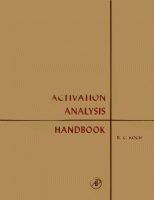Browse content
Table of contents
Actions for selected chapters
- Full text access
- Book chapterNo access
CHAPTER 1 - INTRODUCTION
Pages 1-4 - Book chapterNo access
CHAPTER 2 - ACTIVATION ANALYSIS • THEORETICAL CONSIDERATIONS
Pages 5-10 - Book chapterNo access
CHAPTER 3 - ACTIVATION ANALYSIS • EXPERIMENTAL METHODS
Pages 11-15 - Book chapterNo access
CHAPTER 4 - THE TABULATION
Pages 16-193 - Book chapterNo access
GLOSSARY
Pages 195-197 - Book chapterNo access
BIBLIOGRAPHY
Pages 199-209 - Book chapterNo access
ADDENDUM TO THE BIBLIOGRAPHY
Pages 210-212 - Book chapterNo access
INDEX
Pages 213-219
About the book
Description
Activation Analysis Handbook focuses on the importance of activation analysis in the examination of trace elements in materials. The book contains examples of activation analysis techniques and application of these techniques to provide solutions to problems in various scientific disciplines. Divided into four chapters, the book starts by giving an outline of the history and growth of activation analysis, including the general technique involved. The discussions proceed by taking into consideration the theoretical aspects of activation analysis, giving emphasis to basic concepts, sources of nuclear data and experimental methods, and selection of activation reactions. The book also considers the experimental methods in activation analysis. Other topics discussed are irradiation facilities; the preparation and encapsulation of samples; irradiations; and post-irradiation assays. The last part deals with the tabulation of elements and their corresponding atomic numbers; the key to tabulation; and a tabulation of nuclear data and experimental methods for activation analysis. The text is a good source of data for readers who are interested in activation analysis.
Activation Analysis Handbook focuses on the importance of activation analysis in the examination of trace elements in materials. The book contains examples of activation analysis techniques and application of these techniques to provide solutions to problems in various scientific disciplines. Divided into four chapters, the book starts by giving an outline of the history and growth of activation analysis, including the general technique involved. The discussions proceed by taking into consideration the theoretical aspects of activation analysis, giving emphasis to basic concepts, sources of nuclear data and experimental methods, and selection of activation reactions. The book also considers the experimental methods in activation analysis. Other topics discussed are irradiation facilities; the preparation and encapsulation of samples; irradiations; and post-irradiation assays. The last part deals with the tabulation of elements and their corresponding atomic numbers; the key to tabulation; and a tabulation of nuclear data and experimental methods for activation analysis. The text is a good source of data for readers who are interested in activation analysis.
Details
ISBN
978-0-12-395509-8
Language
English
Published
1960
Copyright
Copyright © 1960 Elsevier Inc. All rights reserved.
Imprint
Academic Press
